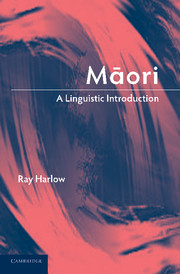Book contents
- Frontmatter
- Contents
- List of figures
- List of maps
- List of tables
- Acknowledgements
- List of abbreviations
- Introduction
- 1 Māori literature and literature on Māori
- 2 A brief history of Māori
- 3 Regional variation in Māori
- 4 The phonology of Māori
- 5 The morphology of Māori
- 6 The syntax of Māori
- 7 The sociolinguistic situation of Māori
- References
- Index
2 - A brief history of Māori
Published online by Cambridge University Press: 28 January 2010
- Frontmatter
- Contents
- List of figures
- List of maps
- List of tables
- Acknowledgements
- List of abbreviations
- Introduction
- 1 Māori literature and literature on Māori
- 2 A brief history of Māori
- 3 Regional variation in Māori
- 4 The phonology of Māori
- 5 The morphology of Māori
- 6 The syntax of Māori
- 7 The sociolinguistic situation of Māori
- References
- Index
Summary
The various types of records referred to in the previous chapter allow us to gain some picture of what has happened in Māori over the last two centuries. As will be seen later in this chapter, it is mostly in the area of vocabulary that developments have occurred over this period, though there is evidence of some change in details of phonology and grammar. In all three areas, contact with English has predictably been a major factor. At the same time, there have been extensive changes in the domains in which Māori is used. These will be discussed in chapter 7.
For an idea of the development of Māori before this period, we are reliant upon the reconstruction methods of historical linguistics. As mentioned, Māori is the most southerly member of the Austronesian (AN) language family. There has been very considerable research carried out on the subgrouping relationships within this language family, as well as on the reconstruction of Proto-Austronesian (PAN) and of the proto-languages of lower-order groupings, especially, in our case, Proto-Oceanic (POC) and Proto-Polynesian (PPN). Such research, along with the investigation of the movements and cultures of the speakers of these languages, sheds a great deal of light on the history and origins of Māori.
Space precludes a thorough account of all aspects of the remote history of the language family, for which there are in any case very good, accessible sources in the linguistic and anthropological literature.
- Type
- Chapter
- Information
- MaoriA Linguistic Introduction, pp. 10 - 40Publisher: Cambridge University PressPrint publication year: 2007

